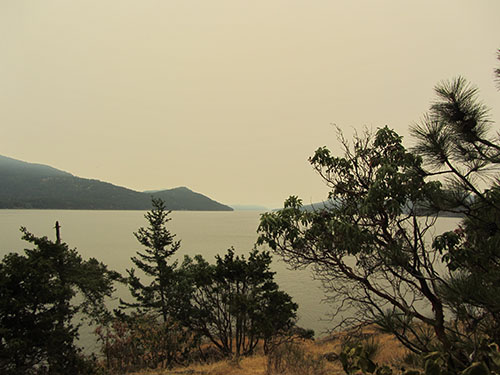The citizens committee involvement in a potentially life-changing county ordinance was completed in April. Or was it? Advisors and the public voiced their dismay with the process at the Orcas Island Town Hall meeting last Thursday.
County Administrator Pete Rose presented the history of the Critical Areas Ordinance before entertaining questions from the audience, which filled the Eastsound Fire Hall on Aug. 6
History of the Critical Areas Ordinance
The County’s [intlink id=”critical-areas-ordinance-update-qa-on-thursday” type=”post”]Critical Areas Ordinance[/intlink] applies to five “areas”: wetlands, fish and wildlife, critical aquifer recharge area, frequently flooded areas, and geological hazardous areas.
As part of the Growth Management Act, by law, the Critical Areas Ordinance (CAO) must be updated periodically. The current undertaking is in compliance with the update scheduled in San Juan County for 2006. In 2007, a citizens committee was formed to advise the council.
However, in 2008, the State Supreme Court ruled in the “Anacortes decision” that the state Shoreline Management Act supercedes the Growth Management Act (GMA) in controlling shoreline regulation. The shoreline critical areas can only be addressed by the Shoreline Management Plan. (SMP). That update is scheduled for 2012 in SJ County.
The Puget Sound Partnership contracted with the County for a $33,5000 grant to prepare the update for the shoreline and uplands portions of the CAO.
The shoreline portion was taken off the table by the Supreme Court decision; the County Planning and Development Department (CDPD) will prepare the shoreline portion and the citizens advisory committee has dealt with the uplands portion of the ordinance from July 2008 to April 2009. Their findings were delivered to the county on June 30 2009.
Three public meetings followed that presentation, and comments on the CAO update drafted ended in late July.
[intlink id=”council-to-revise-critical-areas-ordinance-aug-25″ type=”post”]A public hearing[/intlink] is scheduled for Aug. 25, when there will be a council workshop soliciting input relating to the CAO. The upland portion of the CAO is then likely to appear on the council’s annual docket after first going to the Planning Commission. The Council will decide upon the ordinance after public hearings.
The process with the shoreline component of the CAO update has not bee determined yet. It must be accomplished through the Shoreline Master Plan update, which isn’t due until 2012, or through “a more formal process,” said County Administrator Pete Rose; the council will decide which route to take at their Aug. 10 meeting. The discussion is scheduled to being at 10:50 a.m.
Public input
Ed Sutton asked, “What are the implications of this ordinance on the individual property owner?”
Rose punted, saying, “It means a lot,” and referred the question to John Evans, former County Commissioner, who said, “It affects every piece of property differently… please pay attention and take some time and educate yourselves. There are serious challenges ahead.”
Examples of buildings becoming non-conforming structures if shoreline definitions change, and the requirement to place buffers on all streams followed — “[Property]that has water running in it three months of year, is encumbered by the buffer; you have no use of it , you still own it, can look at it – and pay taxes on it – but that’s about all.”
Accomplishing “balance” within the GMA was said to be the goal of the CAO update, but Patty Miller questioned the public process, saying that the $33,500 granted was “to improve the public participation process, but only three or four meetings were held; how could this spend $33,500?”
Miller, who served on the citizens committee, asked the Council representatives, “This is a complicated ordinance — how could you move forward with such a woeful public process? Are you willing to move it forward with the current public process that’s now in place?
Council Member Richard Fralick agreed: “We have to look at public process. I don’t think it’s adequate either.”
Martha Farish, spoke of the uplands portion of the CAO, saying, “It’s woeful in the extreme…. Please read the ordinance; please reject the process.”
“Do not rush ahead with this until you have the chance to realize you are putting pressure on all the areas you’re trying to protect.”
Fralick noted that the information was on the county website; however Farish observed that it was very difficult to access information about the CAO updates. (The website can be found at https://sanjuanco.com/cao/
Janet Alderton commented that there was much “CAO misinformation — that “it would take away all your property rights…There are benefits to your environment that we moved to the county for, and I think we have to take that into consideration.”
Adam Farish said, “The CAO is of great importance to my family,” and asked county officials and the public to “Question the kind of place we’d like to live in and the kind of representation we’d like to have.”
Adam Farish appeared to questioned compliance with the Growth Management Act, saying, “The CAO is supposed to protect salmon and protect orca whales. If we start from position that we’re in violation of Mother Nature, then the CAO makes a lot of sense… but if you start that we’re one of the most environmentally conscious places in the country, it seems to me that they should be taking advice from us instead of us taking mandates from them.
“At some point, somebody’s got to say ‘That doesn’t work here.’ I’d like to live in a place where we have the foresight and wherewithal and backbone and takes something that’s politically mandated and say ‘Thank you, that’s not for us.’”
Fred Klein argued that while it’s “true there’s a mandate that we have a Critical Areas Ordinance, the specifics are very clearly to be determined locally, not mandated by the state – and while the State could challenge us … this is an opportunity for us to deal with this locally.”
Klein added that his “sense is that the state recommendations were being treated as mandates by committee and I think that’s reflected in the ordinance.






